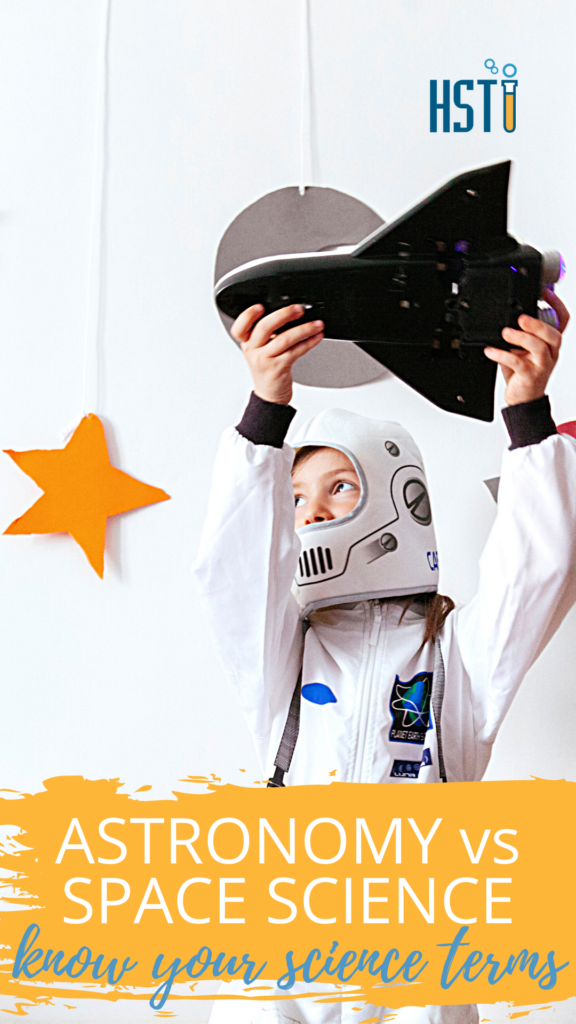Science can be split up into several fields of study. If you’ve been looking for a one-stop resource to give you a flyover view of many of the different studies of science — you’ve found it! We’re going to dive into what space and earth sciences are—and some of their sub-areas of study!
Space Science
Space Science is such a fun part of science! The term space science is used as a general blanket term for all the disciplines of science. Space Science includes exploring space, the study of natural phenomena (moonbow, blood moon, etc), the study of things like space medicine (doesn’t that sound super neat!), and astrobiology.
Take a look at some of the branches in space science and a brief description of what these studies of science are:
- Astronomy is the study of the universe beyond Earth.
- Astronautic: is the theory and practice of travel beyond Earth’s atmosphere into outer space.
- Astrobiology is the study of life in the universe.
- Astrobotany is the study of plants in space environments.
- Astrochemistry: is the study of the abundance and reactions of molecules in the Universe, and their interaction with radiation.
- Astrophysics is a branch of space science that applies the laws of physics and chemistry to explain the birth, life, and death of stars, planets, galaxies, nebulae, and other objects in the universe. Astronomy is often referred to as its sibling.
- Space archaeology: is the study of human artifacts in outer space
- Cosmology is the study of the science of the origin and development of the universe.
- Planetary science is the study of the celestial bodies that orbit stars — mostly focused on our own solar system.
- Microgravity environment research is the study of microgravity. Microgravity is the condition in which people or objects appear to be weightless.
- Forensic astronomy: is the use of astronomy to determine the appearance of the sky at specific times in the past.
- Space medicine: is the practice where physicians support the health, safety, and well-being of pilots, aircrews, and astronauts.
- Space architecture: is the theory and practice of designing and building inhabited environments in outer space.
- Archaeoastronomy: is the study of how people understood the sky in the past
- Astroanthropology: looks at all human responses to and interactions with Space to better understand where we might be heading in the future.
Earth Science
Earth science is the study of all things Earth-related. A lot of things! This includes the study of Earth’s properties, processes, and biology. As with space science, there are many branches of study within Earth science.
Take a look at some of the branches in Earth science and a brief description of what these studies of science are:
- Geology is the study of the rocky parts of the Earth and its history.
- Physical geography is the study of the Earth’s seasons, climate, atmosphere, soil, streams, landforms, and oceans.
- Geophysics (and geodesy): in this field, you’ll investigate the shape of the Earth, its reaction to forces, and its magnetic and gravity fields.
- Geochemistry is the study of the composition, structure, processes, and other physical aspects of the Earth.
- Soil science: isthe study of soil as a natural resource on the surface of the Earth.
- Ecology is the study of the relationships between living organisms — including humans and their physical environment.
- Hydrology, oceanography, and limnology: these focus on the movement, distribution, and quality of the water.
- Glaciology is the study of glaciers (or ice) and natural phenomena that involve ice.
- Atmospheric science is the study of the Earth’s atmosphere and its inner-working physical processes.
Check out some neat Earth Science Kits!
Environmental Science
Environmental science is the study of the biological, physical, and chemical processes that take place on Earth. Social, political, and cultural processes that impact the planet are also included in the studies of environmental sciences.
Take a look at some of the branches in environmental sciences and a brief description of what these studies of science are:
- Atmospheric science is the study of the physics and chemistry of clouds, gases, and airborne particles that surround the planetary bodies of the solar system.
- Ecology is the relationship of organisms to each other and to their physical surroundings.
- Environmental chemistry is the study of chemical processes that occur in water, air, terrestrial and living environments — and the effects of human activity on them.
- Geoscience is the study of the Earth’s structure, properties, processes, and biology.






